Prologue
 Back on December 12, 2014, I posted my first ever camera review on this site, for the Argus C3 Match-Matic. The idea to write about an old camera was just something I thought up on a whim and put together that review with my thoughts, and some sample pics I got from that camera. Never in a million years, would I have imagined that nearly five years later, my site would have grown into what it was.Over the years, I’ve refreshed a few posts to bring them up to my current formatting standards, but with this review, I’m leaving that original post as it was when I first published it, and creating an all new article covering the entire Argus C-series. I hope you enjoy it.
Back on December 12, 2014, I posted my first ever camera review on this site, for the Argus C3 Match-Matic. The idea to write about an old camera was just something I thought up on a whim and put together that review with my thoughts, and some sample pics I got from that camera. Never in a million years, would I have imagined that nearly five years later, my site would have grown into what it was.Over the years, I’ve refreshed a few posts to bring them up to my current formatting standards, but with this review, I’m leaving that original post as it was when I first published it, and creating an all new article covering the entire Argus C-series. I hope you enjoy it.
As I began writing this article, I began to hit milestones I had never hit with any previous camera review. My typical review is between four to six thousand words with the largest topping out at eight thousand words. But this time, I shattered the ten thousand word barrier, and hit eleven, then twelve thousands. I couldn’t stop myself, I just kept typing.
After having some sense talked into me by fellow collectors and bloggers, I decided to split up this Argus piece into five separate articles for you to enjoy in smaller parts. This week, I will release one piece at a time, with a full version of the whole article on Friday. The five parts will be:
- I – History of Argus and the C-series
- II – Repairing your Argus
- III – Identifying the Argus C-series
- IV – Using the C3 and Accessory Lenses
- V – My Results
I hope you enjoy reading everything just as much as I had writing it.
Introduction
This is the Argus C-series. First released in 1938 as the Argus Model C, the C-series includes the best selling American camera ever made, the Argus C3. Over 2.2 million were produced over the course of 28 years, the C-series saw many subtle variations and incremental improvements, but generally retained the same brick-like shape and pre-war feature set until the very last cameras came off the assembly line in 1966. The reason for it’s success was it’s unique looks, quality optics, capable feature set, and affordable price. The C-series had an interchangeable lens mount, and had a variety of German made auxiliary lenses available for it. It was used by amateurs, professionals, students, the military, and countless other people in nearly every profession.
Lenses
The original Argus C was designed to be an interchangeable lens camera and that feature was retained throughout the entire series until the last Match-Matic cameras were produced in 1966.
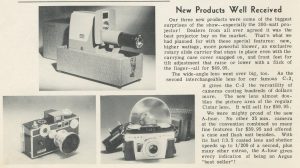
The Argus’s mount is a simple screw mount with a diameter of about 33mm, but with the coupled rangefinder gear present on the Argus C2 and all later models, swapping lenses is a little tricky. I’ll get to changing lenses later, but for now I’d like to cover the various lenses available for the C3. Most people are aware of the German made Enna Sandmar 35mm f/4.5 and 100mm f/4.5 lenses as they were heavily promoted by Argus, but there were quite a few other ones available as well.
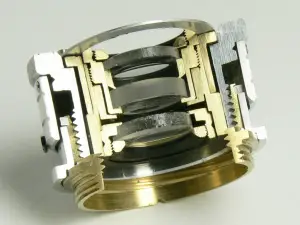
Starting with the standard Argus Cintar lens included on every C-series camera, this was the only lens produced by Argus directly. It is a Cooke Triplet with three lens elements in three groups. Many sites refer to the Cintar as a Leitz Elmar copy, but it is not as the Elmar is a four element in three groups design. They may have both derived from an earlier Cooke design, but the Cintar is not a copy of the Elmar.
Like the Elmar though, the Cintar’s simplicity works in it’s favor as it’s a surprisingly capable lens that delivers sharp and contrasty images with very little undesirable qualities like aberrations, coma, or vignetting which is characteristic of lesser lenses.
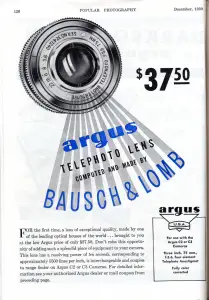
Ads as early as 1938 refer to the Argus C as having an Interchangeable Lens mount, but additional lenses did not become available until at least 1939 when the first mention of a 5-element 75mm f/5.6 telephoto lens made by Bausch & Lomb was available. The ad on the right from the Abe Cohen Exchange’s 1940 catalog shows the lens for an additional $37.50, which is more than the total cost of the camera. Phillip Skerritt’s Argus Rarities page has a picture of an Argus Camera box with a sticker indicating that it has the Bausch & Lomb lens included which suggested they were sold as a kit.
For reasons I was unable to discover, the relationship between Argus and Bausch & Lomb did not continue. There were a couple other companies who made accessory lenses for the C-series, such as Angenieux, Fujita and Soligor, but the most common was Enna-Werk Munchen who produced a 35mm wide angle and 100mm telephoto using the brand name, Sandmar. The two Sandmar lenses were heavily promoted by Argus and at some point were referred to as “Argus-Sandmar” lenses.
Here is a complete list of all known lenses developed for the Argus C-series. Some of these were produced in very limited numbers, which could suggest they were prototypes or special order lenses.
- 35mm f/4.5 Enna-Work Sandmar (in black and chrome)
- 35mm f/3.5 Fujitar Wide
- 35mm f/3.5 Soligor
- 35mm f/4.2 Zeika Wide (rare, ~10 known to exist)
- 35mm Angenieux (extremely rare, ~5 sets made, came with 100mm lens)
- 35mm f/3.5 Robin
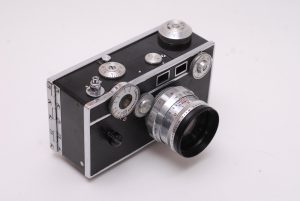
The 53mm f/2.0 Enna Werk Lithagon was the fastest lens ever created for use with the Argus, and is extremely rare. Image used with permission, Phillip Sterritt. - 50mm f/3.5 Argus Cintar (Cintar name first used in 1940, early and later versions)
- 53mm f/2.0 Enna-Werk Lithagon (rare, 3-4 made)
- 75mm f/5.6 Bausch & Lomb (uncommon, ~1000 made)
- 100mm f/4.5 Enna-Werk Tele-Sandmar (in black and chrome)
- 100mm Angenieux (rare, ~5 sets made, came with 35mm lens)
- 135mm f/4.5 Fujitar
- 135mm f/4.5 Robin
- 135mm f/4.5 Soligor (in black and chrome, also Elitar-Soligor variant exists)
I did not have access to any of the rarer lenses in the list above, but I do have examples of the 35mm and 100mm Sandmars and the 135mm Soligor, so I thought it would be interesting to compare the three to get an idea of the range of focal lengths available to the camera.
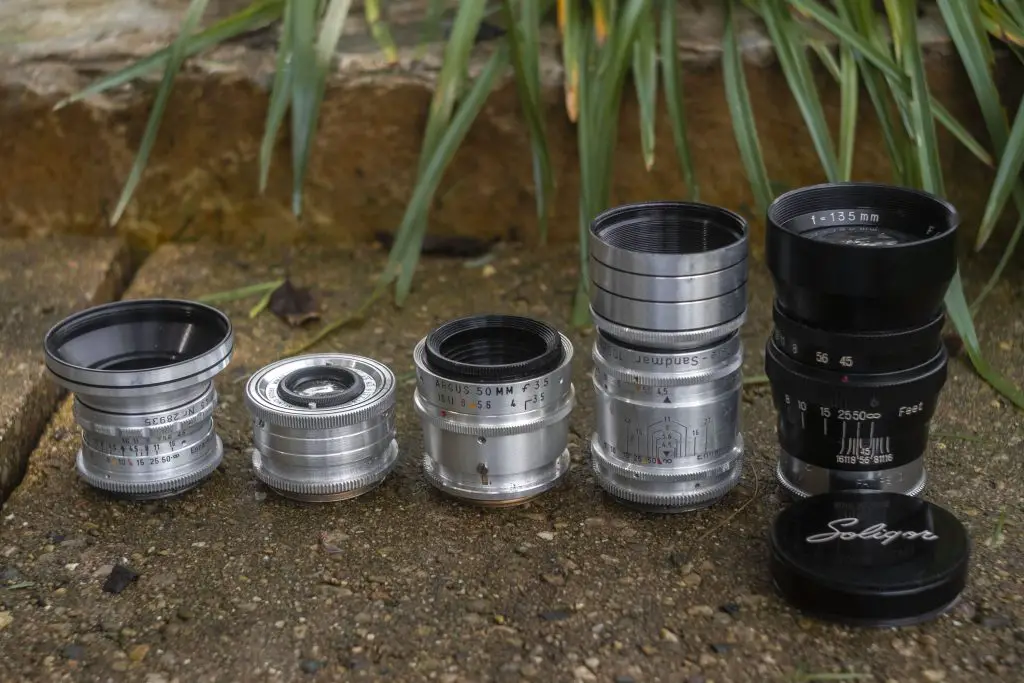
The gallery below was shot on Kodak Vision3 50D film using the C3 Standard, and shows the same scene using the three accessory lenses, plus the 50mm “Standard” Cintar.
As you can see from the four images above, the focal length of the scene above changes from the widest at 35mm to the longest at 135mm, but what’s even more interesting is how each lens renders things a bit differently.
The 35mm Sandmar and 50mm Cintar both render sharp images with little vignetting. The sky takes on a cooler color with the 50mm lens than the wide angle. With the 100mm Sandmar, the sky retains a cool hue, but vignetting is clearly evident in the whole image. Center sharpness is still pretty good. The last image from the Soligor 135mm suffers from camera movement, which is my fault, but the colors seem washed out and there is heavy vignetting near the corners, almost like the lens has gone beyond it’s circle of coverage. I’ll have to experiment more with this lens in the future to see if I can improve things at all.
Using the Argus C3
If you’ve made it this far, it’s probably no surprise that for me to have put this much time and effort into this article, I must be a pretty big fan of the camera, and you’d be right.
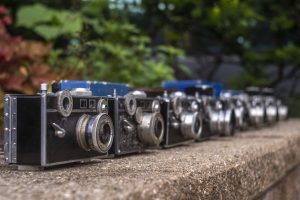
I absolutely adore the Argus C3 and it’s entire family. Part of my fondness is due to the C3 being one of the first vintage cameras I ever handled, and the very first I ever reviewed on the site, but I also have a general appreciation for American made cameras in general. While Germany and Japan clearly were far more adept at making cameras, and had much longer histories doing so than the Americans, I like that pretty much every American camera was it’s own design. There were very few American cameras that look like anything made by the competition. Both the Soviet and Japanese camera industries got their starts copying German designs, and even within Germany, many companies were competing with each other, whereas the Argus released this solid brick of a thing to the masses, and it ends up staying in production for 28 years. What a story!
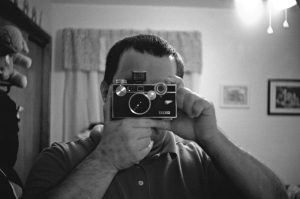
Not every collector has my level of appreciation for these cameras, and I completely understand why. The ergonomics aren’t very good, they’re crude, each time you fire the shutter, it sounds like someone is snapping a metal fork in half, and they’re not exactly pretty (at least that’s what other people say, I like their look.)
But if you’re looking to get started with film photography and want something different than another German rangefinder or Japanese SLR, the Argus is a fine choice. It has a lot of history, once you learn how to use it, it’s not that hard to use, and the lenses are capable of some really nice shots.
Note: For the remainder of this section, I will be using a prewar Argus C3 as it’s control layout is similar to most Argus C-series cameras you’ll find out there. There are a few minor differences with the later Standard, Match-Matic, and Golden Shield variants, which I’ll cover when necessary, but otherwise, everything you see here applies to all cameras.

Starting with the front of the camera, we see the shutter speed dial in the upper right corner. The number of speeds changed quite a number of times throughout the whole series starting as high as 10 speeds, down to 5 by the end. This wheel is designed to be rotated counter clockwise from the fastest speeds to the slowest. You can turn the dial clockwise, but you will feel a stop around 300. Do not try to force this wheel past 300 when turning clockwise (you can do it counterclockwise) or else you may break something.
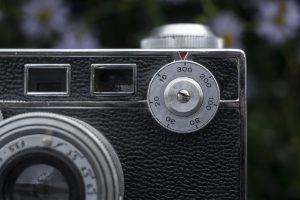
Regardless if you have a 10, 7, or 5 speed model, the Argus’s slow speed escapement is infinitely variable, which means that in between speeds are possible. The numbers printed on the dial only seem to be approximations of what will fire at that point, but if you want something in between 100 and 300, you can do that. From everything I’ve seen online and while disassembling these cameras, the design of the shutter and slow speed governor never seemed to change, which suggests that the same numbers of speeds are attainable regardless of which variant you have. If anyone reading this has any information counter to my theory, please let me know in the comments section below.
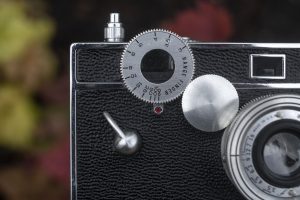
On the left side of the camera is the rangefinder wheel, which is coupled to the lens on all versions of the camera except the original Argus C. The rangefinder has a base that’s approximately 44mm wide, which is just slightly longer than a Leica II/III for improved accuracy and has a range of 3 feet to infinity.
Fun Fact: Although all production Arguses had a focus scale in feet, a very small number made in the late 1930s had a metric scale. It is thought that these were made for special medical or scientific applications.
Below the rangefinder is the cocking lever. This lever must be pressed before each exposure, otherwise the shutter will not fire. The Argus C-series does not have double image prevention so you are free to make as many intentional exposures as you like on the same frame.
Pro Tip: One of the ergonomic failures of the entire C-series is that the cocking lever is in a position that is easily bumped by your hand while shooting the camera. Upon firing the shutter, the cocking lever needs to move freely back to it’s original position and any interference by your hand will delay the closing of the shutter, throwing off your exposure.
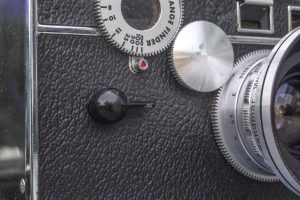
A really great tip is to rotate the lever 180 degrees so that it points toward the lens mount when cocked. To do this, you simply back off the cocking lever by rotating it clockwise (the threads are reversed, so it’s ‘righty loosey’ and ‘lefty tighty’ and then loosening the hex nut behind it just a little bit so that you can tighten the cocking lever and leave it pointing in a different direction than normal.
This might take some trial and error to get it rotated correctly, but when you’re done, it should look like the one in the image to the right. You still need to be careful when holding the camera, but at least this way, the long part of this lever will be facing away from your hand.
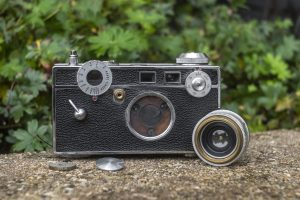
Perhaps one of the more notorious features of the Argus C2 and C3 is it’s interchangeable lens mount. Many people who are not fans of these cameras identify the lens changing procedure to be one of the camera’s worst features. My thoughts on this is that yes, the process for changing lenses isn’t ideal, but I also think it’s not nearly as difficult as some people suggest it is.
There is a ton of information online, including reading the original owners manual for the camera, that show how to change lenses, but I thought that making a video and showing it done with three different lenses would be helpful, so that’s what I did.
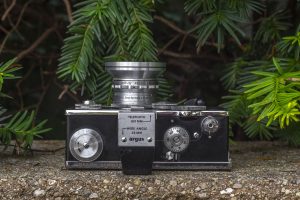
Although not shown in the video, when using any lens besides the 50mm Cintar, you must use an auxiliary wide angle or telephoto viewfinder such as the one in the image to the right. If you’re using a later C3 Standard, Match-Matic, or Golden Shield with an accessory shoe, you may use any viewfinder made for any camera, not just Argus. For the earlier models like this one here, there are Argus specific ones that clip onto the top of the camera over the front and rear viewfinder windows.
As mentioned in the video, if after mounting an accessory lens, the focus scale is not pointing up, you may adjust it by loosening small grub screws in the lens threads. Phil Sterritt has some instructions on how this is done.
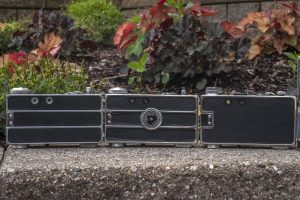
The backs changed over the years, some having three sections of leather, some with one, some have a film reminder dial with Weston speeds, some with ASA speeds. Regardless of which one you have, the back of the camera has two round eyepieces for the main viewfinder on the left and the rangefinder on the right.
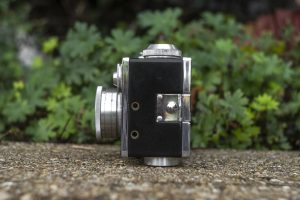
The back of the camera is secured with a chrome latch on the camera’s left side. This latch has a small hook on it that must be pressed inward to overcome. While putting inward pressure onto the latch, pull back on the rear door and it will open.
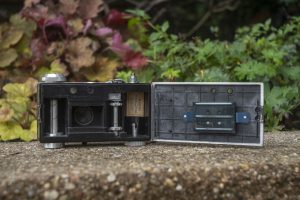
The right hinged door reveals a film compartment in which film travels right to left. This is contrary to how many 35mm cameras work from later in the 20th century, but in 1938 when this camera was first designed, it was pretty normal for film to travel this way.
When loading a new cassette, you must first pull out the rewind knob on the bottom right of the camera. Extend the leader across the film gate and onto the fixed take up spool which has a single large slit going through the middle. The Argus C-series is designed in a way where there is no need for light seals, so typically light leaks shouldn’t be an issue with these cameras.
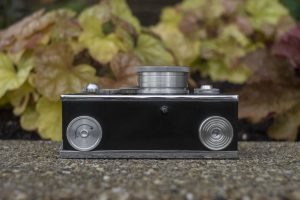
The bottom of the camera has the rewind knob and a matching foot with an integrated 1/4″ tripod socket, and mini kickstand protrusion for keeping the camera level while sitting on a flat surface.
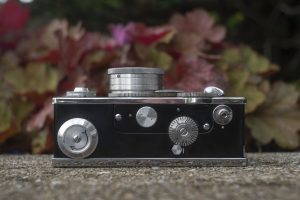
On top from left to right is the large film advance knob. It’s size makes getting a grip on it easy for advancing film.
If this were a C3 Standard, Match-Matic or Golden Shield, there would be a standard accessory shoe to the immediate right of the advance knob, but that doesn’t exist on the earlier models.
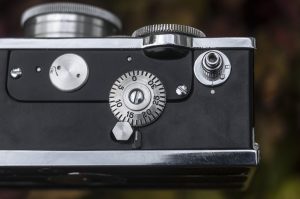
The large chrome circle with the two divots in it is a port for accessing a rangefinder adjustment screw. I explain in the Repairs section earlier in this article how to service the rangefinder either using this port or by removing the rangefinder altogether.
Next is the exposure counter and hexagonal film interlock release switch. The exposure counter is additive and must be manually reset upon loading each new roll of film. Like most 35mm cameras, when advancing film, the film advance will lock when you’ve reached the next exposure. This prevents you from continually advancing the film, wasting unexposed film like you might on an early roll film camera. The interlock release must be pressed prior to advancing the film to each additional exposure. To do this, give a gentle leftward pressure on this switch while turning the film advance knob. Once the interlock has been overridden and the knob starts to turn, you may release pressure on the interlock.
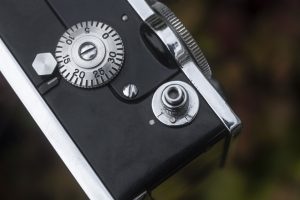
This interlock is also used to rewind film back into the cassette at the end of the roll. By maintaining constant pressure on this switch, you may turn the rewind knob on the bottom of the camera until all of the film is in the camera. While rewinding, the exposure counter will rotate, which is helpful if you want to leave the film leader out of the cassette. Keep rewinding until the exposure counter stops turning, and the leader will be left out of the cassette.
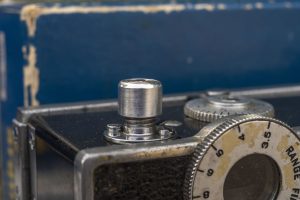
Finally we have the shutter release. The design of the shutter release has changed over the years, from the “mushroom” style of the original models, to the upright threaded one seen here, to the flat design of the later models, but they all support both Instant and Bulb modes.
With the shutter release in Instant mode, the shutter fires at whatever speed the front dial is set to. Rotate it to the B position and the shutter works in Bulb mode, where the shutter will remain open for as long as you provide pressure on the shutter release. This mode also disables flash synchronization on all C3s, disabling the flash. With a locking shutter release cable, you can effectively have a Timed mode in which you could lock the shutter open for very long exposures.

Like pretty much every 35mm rangefinder camera from the 1930s, the viewfinder and rangefinder windows are separate. Although this might seem unusual to someone only familiar with modern cameras, the split window design actually has a benefit in that the main viewfinder window is very bright and easy to compose with. Because the rangefinder window is separate from the main viewfinder, it can be magnified separately, improving your ability to see the split image. The downside of course is speed, because you have to shift your eye between two different windows, but other than that, rangefinders like that of the Argus C-series are usually easier to use than the combined coincident image style that was increasingly popular in the 1950s and 60s which become cloudy and harder to use over time.
Earlier Argus C-series cameras used a blue tinted rangefinder, but this was changed with the postwar models to have a yellow tinted rangefinder, but other than color, the two designs work exactly the same.
Please come back tomorrow for Part V – My Results.

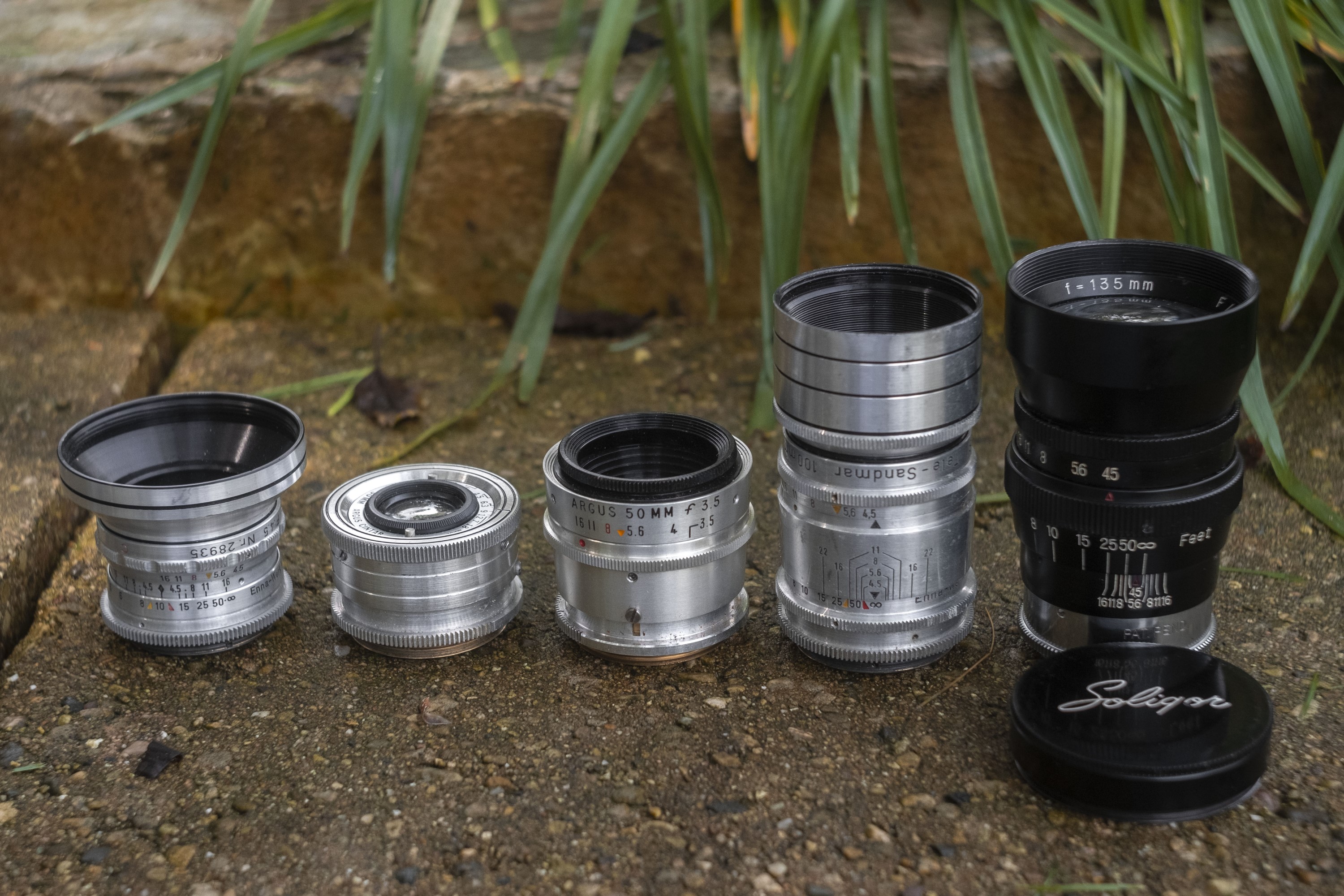
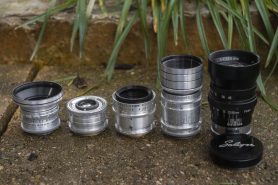
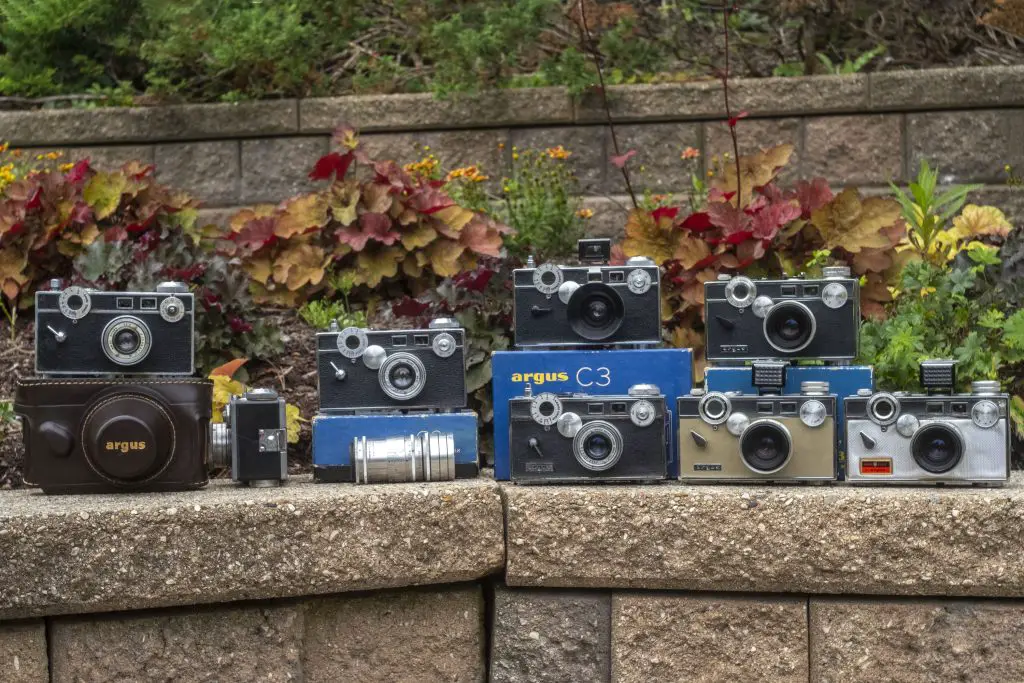
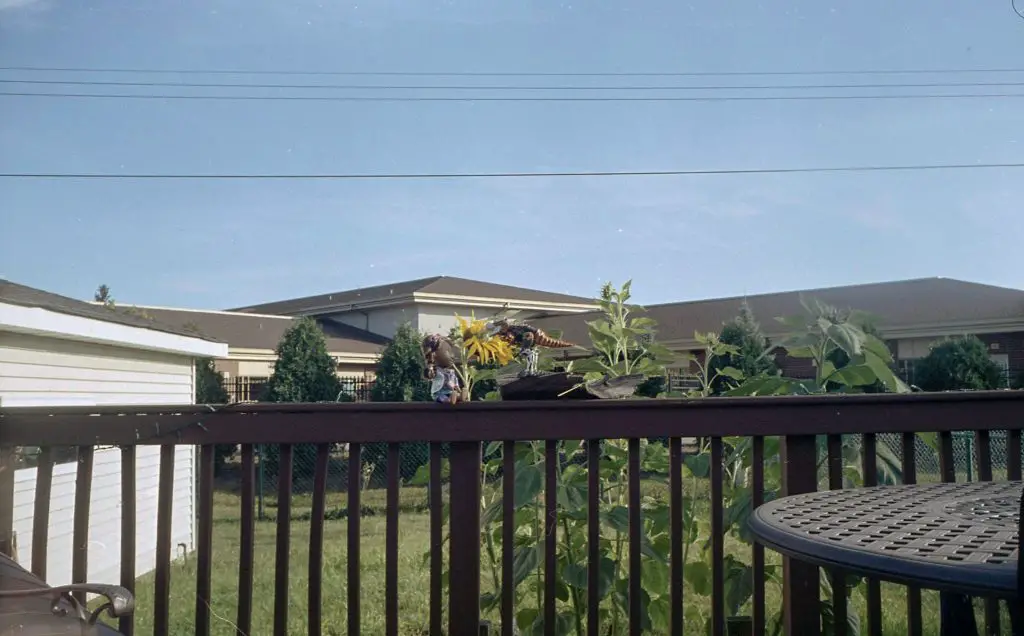
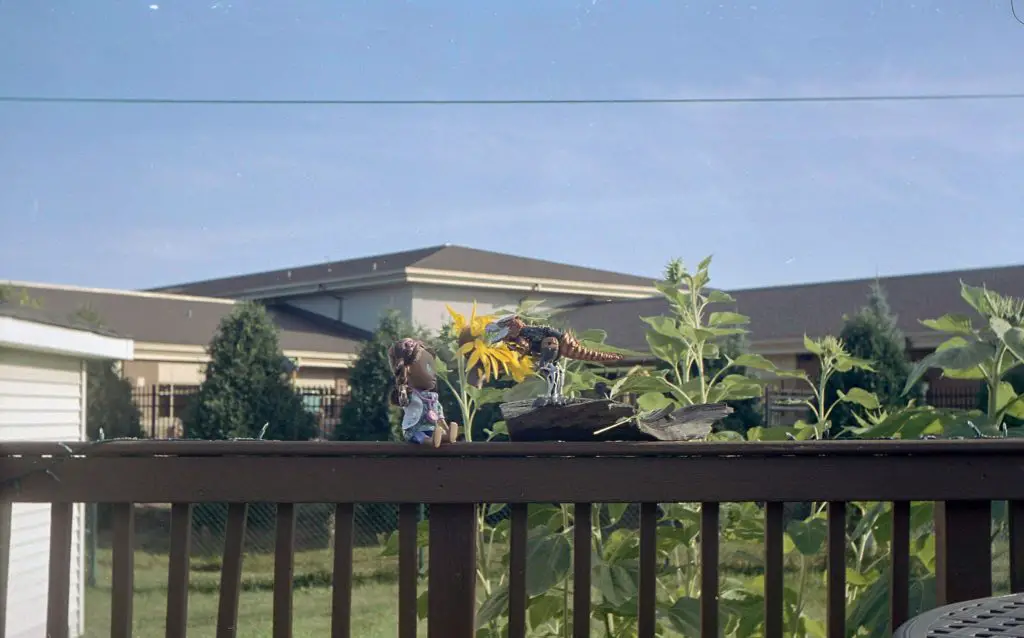

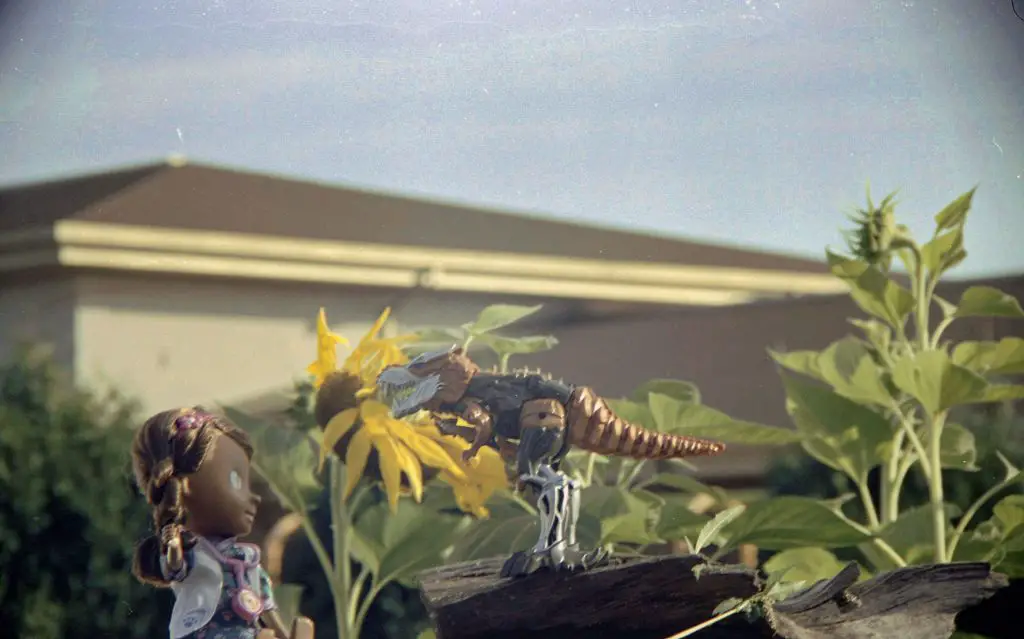
Mike, I wonder how many orders went to Argus for replacement coupling gears and covering caps for those that were lost? Or did the majority of users simply not bother with changing lenses at all? Not difficult, but what a faff.
I imagine it did happen, but probably not that often. Of the 2+ million Argus C3s sold over the years, I have to imagine that not many people changed the lenses. Based on the frequency of how often the other lenses show up, my guess is that a majority of cameras kept the same lens it was originally sold with, throughout it’s life.
Mike, this is a great series: You’ve taken a serious look at a family of cameras that many of us sort of wrote off as kludges. A couple notes about the non-Enna lenses: Robin was a model name applied to a late-1950s Taron 35mm RF camera. I’ve only seen it fitted with a 45mm f1.9 Taron (or Taronar) lens. There may be a tie-in to Neoca, the Yashica predecessor, in this camera’s lineage. I recall seeing a Taron Robin over a decade ago on eBay with a Zunow lens, that went for a few hundred $$ (but not to me).
.
Fujita made the Kalimar/Soligor 66 medium format SLR during the early 1960s. They also made a few lenses for 45mm mounts: I once had a Fujita 35mm f2.8 in Exakta mount one of the few Japanese lenses made for Exakta. The website MFLenses reports on Fujitar HC preset lenses, probably in M42 mount. One contributor says Fujita private-branded their lenses during the 1960s for at least one US camera store, Peers: http://forum.mflenses.com/fujitar-t12398.html
Fujita lenses for 35mm camera mounts, not 45mm mounts. Sheesh, we could use an “edit” button on comments!
Great series, thanks for taking the time to spread the word about Argus and the C3. Just a few minor nits to pick about the lenses you have listed…
There were more than 10 Zeika’s made. Based on serial numbers I have logged, there are 8 recorded, spanning serial numbers 0074 to 0333. So perhaps 350 made?
You mention the Fujitar lenses, I think they are distinct from the Robin lenses, unless you know of something I do not. You can tell some of the Fujitar/Soligor/Robin models were made by the same company. All the 135’s except for the Elitar-Soligors are the same. The Robin and Fujitar 35’s are the same, and there are two variations on the Soligor’s, one of which is the same as the Robin/Fujitar, though it is a good bit more rare. As for the Robin lenses, I only have three recorded in my notes of each spanning very narrow serial number ranges.
The Angenieux lenses are certainly among the most rare, only one of each is known to exist. Argus acquired about 5 of each for review, an Argus employee who had the known set said he did lens testing with them. At least one set was taken apart to evaluate how it was made or some such. Who knows what happened to the others or if they still exist. They were never sold, so I don’t think you could call them a set.
I could share further information about the C3 lenses and serial number ranges, but your readers probably wouldn’t care… 🙂
Wesley, thanks for the compliment and for your great information! I got the number of 10 Zeikas from Phil Sterritt’s Argus rarities page where he says there are 10 known to exist. I can see how there might have been more made, just only 10 known samples. I’ll clarify that in the review.
As for my theory on whether the Fujitar and Robin possibly being the same simply because they look so similar. Perhaps that was an unnecessary reach though!
And in response to something I saw you post on Facebook, you absolutely should take some of these lenses out and shoot them. They’re lots of fun! 🙂
I bought my first Argus C3 Matchmatic at a garage sale for $5. After doing some research and knowing that these cameras were made in my hometown of Ann Arbor, I had it CLA’d and replaced the leather with a dark green leather with wood trim on the top. Now I have 3 bricks and 6 lenses ..the Soligor 35mm, the Sandmar 35mm, 2 Cintar 50mms and 100mm plus the Soligor 135mm. I am still not sure about the flash as it is hit and miss, perhaps due to old flash bulbs. The uncoated Cintar 50mm is intriguing as if should have potential for UV photography since there are only three air spaced lenses. Lens elements that are cemented together and lens coatings block more uv light. With a UV transmitting filter and the old Fujichrome Type II tungsten film you should get some good results. Another great feature of the Argus lenses is that you can insert Series V filters between the lens and the built in hood. The Cintar 50mm lens used on the older C2 and C3 cameras I think used series IV filters. Leica actually did make a 90mm triplet Elmar but these are rare and pricey. In summary I like these cameras because they are well made, have interchangable lenses, affordable, allow for double exposures are compact and do not have vibration due to mirror lock-up. They were also the camera of choice for many GI’s in WW2.
Thanks for your great article. It is especially helpful for those trying to change lenses on this camera for the first time.
John Flinn
Thanks for the kind words, John. I think most people start their Argus collection with a $5 garage sale find! I bought one once for $1, only because the guy didn’t want to give it away for free, and had to ask at least a $1 to feel good about himself. I laughed and gladly gave him a dollar!
Mike, I have a Votar 1.5in f/1.4 cine lens that I cannot find any information on. Any pointer would be appreciated. My serach terms are not working or there’s just not many out there people care about.
I am sorry, but I don’t know anything about that lens either. Apart from the usual Google searches, perhaps joining some kind of cine lens group on Facebook or Reddit might help you out.
Great article, and I’m glad to have stumbled across this! I also happen to have two Argus cameras that were gifted to me. While I’ve never used the cameras, I located a custom lens adapter and have been very happy with the results when mounting the Cintar 50mm lenses (both the pre-war and coated versions) on my Fuji X series cameras. Question: what is the filter thread of the newer, coated version? I’ve heard these can be 33mm or even 33.5mm. My coated version also came with a plastic insert ring that screws into the filter thread, which is the same as seen in your photo. Is that a step-up or conversion ring of some kind?